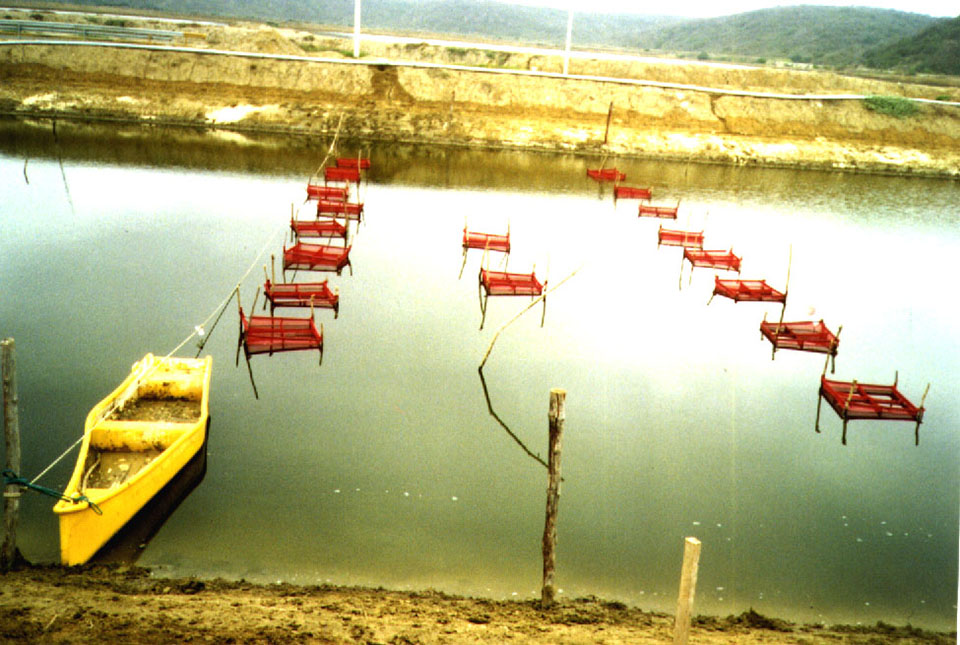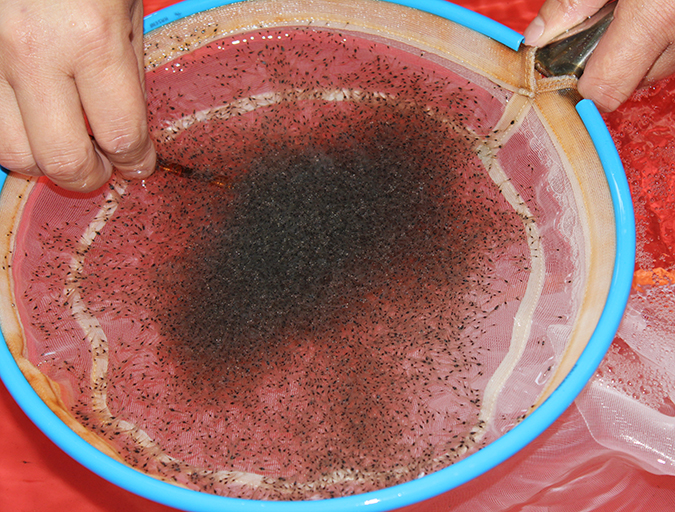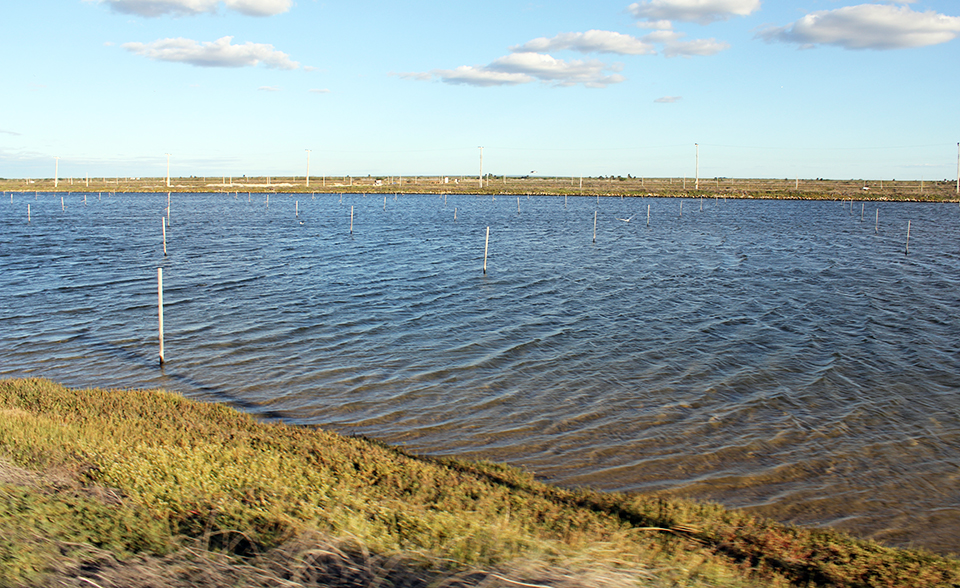Differences in survival were measured for density and transport time

The cumulative effects of hatchery harvest, packing, temperature change, transporting, and acclimation prior to stocking exert stress on shrimp postlarvae. Appropriate techniques for penaeid shrimp seed-stock transport and acclimation are therefore important to ensure maximum survival in nursery and grow-out ponds.
Few relevant, comparative studies on the subjects are available. At the National Aquaculture and Marine Research Center (CENAIM) in Guayaquil, Ecuador, several experiments supported by the Council of Flemish Universities were conducted to evaluate the effects of transportation factors on the survival of Litopenaeus vannamei PL after acclimation.
Experiment 1
Experiment 1 incorporated three PL densities (125, 250, and 500 PL per liter) and three transporting times (three, six, and nine hours) following a 3 x 3 treatment design with 4 replicates per treatment. PL25 were randomly allocated at about 95 to 105 PL per gram in 1-liter, airtight plastic bags with saturated oxygen. PL survival was estimated after each transporting time by counting all the larvae in the treatments bags. The water in the transporting bags registered temperatures of 27 to 28 degrees-C and salinity of 34.5 grams per liter.
Experiment 2
Experiment 2 used densities of 250, 500 and 750 PL per liter, and transporting times of three, six and nine hours. Shrimp were transported in two types of containers: 20-liter buckets with aeration and 20-liter airtight plastic bags with saturated oxygen. The operational volume in each container was 15 liters. Water temperature in the transporting units was reduced to 22-23 degrees-C with ice packs.
Acclimation
After transport, postlarvae were acclimated to pond water conditions and stocked in 0.4 x 0.4 x 0.4-meter floating cages fixed inside a commercial shrimp pond, or acclimated and seeded in 50-l glass aquariums at CENAIM. PL were acclimated to the 41 grams per liter pond water salinity at a rate of 2 grams per liter per hour. The shrimp stocked in the glass aquariums required only temperature acclimation.
Survival for each treatment combination was evaluated after four days by counting the live PL remaining in the floating cages or aquariums. Water temperatures in the ponds and aquariums ranged 24 to 26 degrees C. PL were fed microparticulate feed in 6 rations per day. Water exchange in the aquariums was set to 30 percent per day.
Results
Significant (P < 0.05) differences in PL25 survival were measured for density and transport time in experiment 1. The best significant survivals were observed at the lowest density and shortest transport time (Table 1).
Cobo, PL survival after transport at three densities, Table 1
| Time (hours) | Density (PL/liter) 125 | Density (PL/liter) 250 | Density (PL/liter) 500 | Average |
|---|---|---|---|---|
| 3 | 99.2 | 99.4 | 95.4 | 97.1a |
| 6 | 92.9 | 99.3 | 88.2 | 98.1a |
| 9 | 99.2 | 95.8 | 87.1 | 90.2b |
| Average | 98.0a | 93.5b | 94.0b |
In experiment 2, no significant differences in survival were found after four days of holding for PL density, type of container, and transporting time in either floating cages or aquariums.
Acclimation to 41 grams per liter salinity pond water had no effect on PL survival. Although not statistically significant, the postlarvae acclimated to pond water showed slightly higher survival (overall average 76.3 percent) than the aquarium PL (average 71.9 percent).
(Editor’s Note: This article was originally published in the December 2003 print edition of the Global Aquaculture Advocate.)
Now that you've reached the end of the article ...
… please consider supporting GSA’s mission to advance responsible seafood practices through education, advocacy and third-party assurances. The Advocate aims to document the evolution of responsible seafood practices and share the expansive knowledge of our vast network of contributors.
By becoming a Global Seafood Alliance member, you’re ensuring that all of the pre-competitive work we do through member benefits, resources and events can continue. Individual membership costs just $50 a year.
Not a GSA member? Join us.
Authors
-
María de Lourdes Cobo, M.Sc.
Centro Nacional de Acuicultura e Investigaciones Marinas
Campus Politécnico
Casilla 09-01-4519
Guayaquil, Ecuador[99,101,46,117,100,101,46,108,111,112,115,101,46,109,105,97,110,101,99,64,111,98,111,99,108,109]
-
Stanislaus Sonnenholzner, Ph.D.
Centro Nacional de Acuicultura e Investigaciones Marinas
Campus Politécnico
Casilla 09-01-4519
Guayaquil, Ecuador
Tagged With
Related Posts

Health & Welfare
Acclimating shrimp postlarvae before pond stocking
Shrimp postlarvae acclimation before stocking into the various growout systems (ponds, raceways, tanks) is a critical – and often overlooked, sometimes taken for granted – step in the shrimp culture process. Various water quality parameters should be changed slowly so that the young shrimp have the time to gradually adapt to the new conditions.

Health & Welfare
A comprehensive look at the Proficiency Test for farmed shrimp
The University of Arizona Aquaculture Pathology Laboratory has carried out the Proficiency Test (PT) since 2005, with 300-plus diagnostic laboratories participating while improving their capabilities in the diagnosis of several shrimp pathogens.

Health & Welfare
A holistic management approach to EMS
Early Mortality Syndrome has devastated farmed shrimp in Asia and Latin America. With better understanding of the pathogen and the development and improvement of novel strategies, shrimp farmers are now able to better manage the disease.

Health & Welfare
AHPN inferences based on behavior of vibrio bacteria
Vibrio parahaemolyticus, a strain of which is the cause of acute hepatopancreatic necrosis (AHPN), has both virulent and benign strains. This strain colonizes the stomachs of shrimp by the formation of a biofilm, which protects it from antibiotics and other potential treatments.


